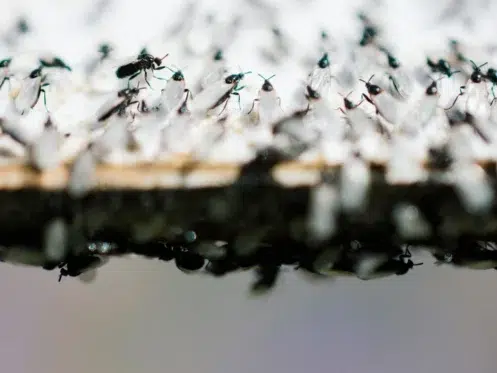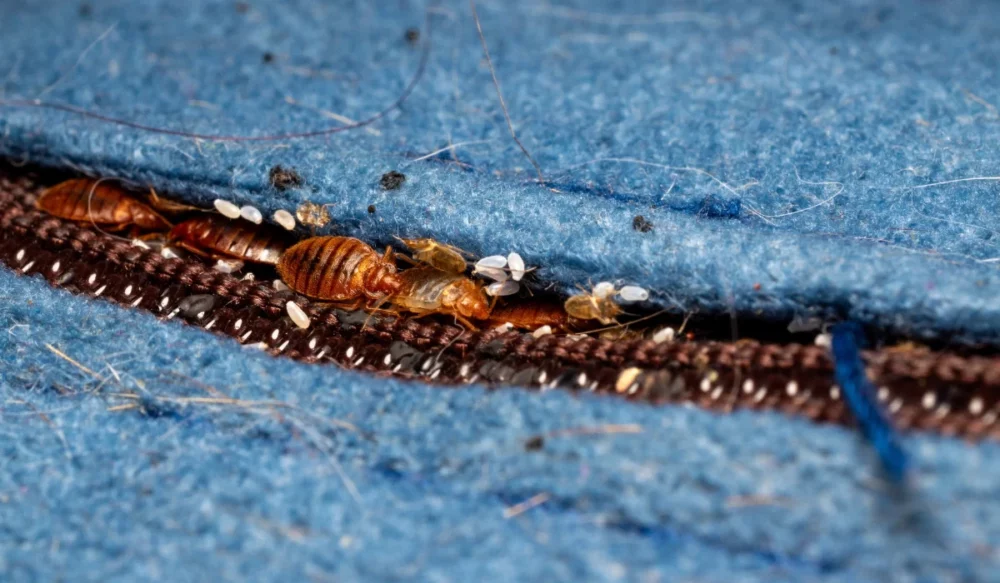Each year in Arizona, many people see swarms of winged insects during monsoon season and ask: Are they flying ants or termites? They look alike at first, but the difference matters. Flying ants are often a nuisance. Termites feed on wood and other cellulose and can cause costly, hidden damage.
This guide covers flying ants vs termites in Arizona, how to spot swarmers, when swarms happen, and what to do if you see them near your home.
Knowing the signs helps you decide if it’s a minor ant issue or a termite problem that needs professional service.
Key Takeaways
- Flying ants have bent antennae, a narrow waist, and wings of unequal length. Termites have straight antennae, a broad waist, and equal-length wings.
- Arizona termite swarmers appear mostly during the monsoon season and signal a possible infestation.
- Flying ants are often harmless, but carpenter ants can still damage wood structures.
- Professional termite inspection and pest control services are the best way to prevent hidden damage.
Flying Ants vs Termites in Arizona: Key Differences

Flying ants and termites may look similar at first, but their bodies are different. Flying ants have a narrow waist, bent antennae, and longer front wings. Termite swarmers have a broad waist, straight antennae, and equal-length wings.
Color helps too: flying ants are usually dark brown or black, while swarmers are often lighter. Watch the body and wings to tell if the insects by your windows are ants or termites starting a new ant colony or termite nest.
Why Termite Swarmers Matter in Arizona
Termites don’t fly for fun. Swarmers are the reproducers that leave to start new colonies. In Phoenix, Chandler, Scottsdale, and Tucson, a swarm often means an established termite infestation is nearby.
Termites eat cellulose in wood, paper, and even drywall. They often cause hidden structural damage before any signs show. Mud tubes, piles of wings, or bubbling paint usually appear later. Seeing swarmers is one of the earliest warning signs.
Common Times to See Flying Insects in Arizona
In Arizona, swarms usually happen during monsoon season, especially after evening rain. You might see clouds of flying ants or termites gathering near lights or hovering around homes at dusk.
Flying ants can originate from carpenter ants or other species that are starting new nests. Termite swarmers are more urgent. In Tucson and Phoenix, swarms are common in summer and early fall. If you see swarmers indoors, a colony may be in the walls or foundation.
Flying Ants: What Arizona Homeowners Should Know
Many flying ants are not a big problem and only cause short swarms, depending on the ant species. Carpenter ants are different. They tunnel through wood to make nests and can weaken beams over time. They don’t eat cellulose like termites, but their digging still damages wood.
Carpenter ants like damp or rotting wood. Seal entry points and reduce moisture around the foundation to prevent water from entering. If you see winged ants indoors, schedule an inspection to check for a nest in the walls.
Flying Termites: A Serious Threat
Winged termites are always a warning sign. Swarmers start new colonies that can spread fast. Since termites eat cellulose, they can hollow out beams, floors, and drywall from the inside.
Once termites move in, professional inspection and treatment work best. DIY products rarely reach the whole colony because termites hide deep in soil or wood. Arizona pros use proven treatments to remove colonies and prevent future swarms.
How to Tell Them Apart Quickly
If you’re not sure, check three traits:
- Antennae: Ants have bent antennae; termites have straight antennae.
- Waist: Ants have a pinched waist; termites have a broad waist.
- Wings: Ants have front wings longer than back wings; termites have equal-length wings that shed easily.
Piles of shed termite wings on sills or floors mean swarmers have already come inside and are looking for nesting sites.
Preventing Swarms and Infestations
Prevention is the best defense for ants, termites, cockroaches, and bed bugs. Cut food sources, seal entry points, and fix moisture problems to lower risk.
For termites, keep soil and wood separate, reduce moisture near the foundation, and watch for mud tubes along walls. Termite activity often stays hidden, so schedule regular inspections to protect your home.
Professional Pest Control in Phoenix and Tucson
If you notice swarmers inside or outside your home, it’s best to act quickly and call a trusted pest control company. Green Home Pest Control provides termite control, carpenter ant solutions, and year-round pest control services designed for Arizona homes.
DIY sprays and traps often miss hidden nests. Our Phoenix and Tucson specialists can pinpoint whether you’re dealing with flying ants, termites, or other pests, then recommend the right solution for long-term protection.
Making the Right Choice for Your Arizona Home
Flying ants may be only a short-lived nuisance, but termite swarmers often signal a larger problem that can lead to severe damage if ignored.
Knowing the difference helps you respond before colonies grow stronger. Green Home Pest Control has the local knowledge and proven treatments to protect homes across Arizona.
Contact us today to schedule your inspection and safeguard your home.
FAQs
When do termites swarm in Arizona?
In Arizona, termites swarm in summer and early fall, often after monsoon rains. Seeing them indoors usually means a colony is already active nearby.
How can I tell if I have flying ants or termites?
Check their body shape, wings, and antennae. Flying ants have a pinched waist, bent antennae, and wings of unequal length. Termites have a broad waist, straight antennae, and equal wings.
Do flying ants cause as much damage as termites?
Not usually. Most flying ants are harmless, but carpenter ants can tunnel through wood to build nests. Unlike termites, they don’t eat cellulose but can still weaken wooden beams if left untreated.




